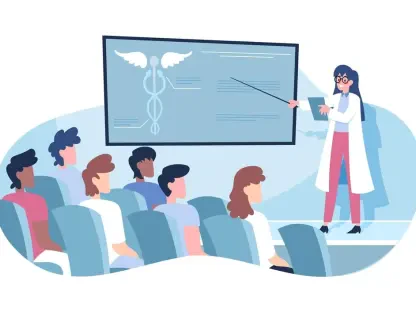In rural India, where 71% of the population resides but only a third of physicians practice, the stark reality of healthcare access paints a grim picture—a doctor-to-patient ratio of 1:11,082, far below global standards, leaving millions to face long journeys for basic medical care at prohibitive costs. Critical health issues often go untreated, but AI health chatbots are emerging as a groundbreaking technological intervention designed to bridge this gap by delivering medical guidance and support directly to smartphones in remote villages. This review explores how these digital tools are transforming healthcare delivery, focusing on their innovative features, real-world impact, and the challenges they face in reshaping access to care for underserved communities.
Core Features of AI Health Chatbots
Diagnostic and Teleconsultation Capabilities
AI health chatbots are engineered to provide preliminary diagnostic support, analyzing symptoms reported by users to offer initial assessments. Platforms like CureBay utilize sophisticated algorithms to evaluate patient inputs, guiding them toward appropriate care pathways before facilitating teleconsultations with doctors. This dual approach significantly reduces the strain on limited medical personnel in rural areas, where healthcare facilities are often sparse.
The accuracy of these diagnostic tools, while not a replacement for in-person evaluations, has shown promise in identifying common ailments and escalating complex cases for human intervention. For rural patients, this means faster access to advice without the need for immediate travel, cutting down both time and financial burdens. The integration of teleconsultation further ensures that expert opinions are just a call away, even in isolated regions.
A notable impact is the scalability of such systems, allowing thousands of patients to receive simultaneous support. This capability is vital in areas with high population density but low healthcare infrastructure, ensuring that basic medical queries do not go unanswered due to logistical constraints.
Multilingual and Voice-Enabled Accessibility
Accessibility remains a cornerstone of AI health chatbot design, particularly through multilingual support and voice interaction features. Tools like ASHABot, developed by Khushi Baby, cater to diverse linguistic needs by operating in Hindi, English, and Hinglish, making them usable for a broad spectrum of rural users. The inclusion of voice note functionality is especially critical for illiterate populations who may struggle with text-based interfaces.
This focus on language diversity breaks down significant barriers, as many rural residents are more comfortable communicating in regional dialects or through spoken word. By accommodating these preferences, chatbots enhance user engagement, ensuring that vital health information reaches those previously excluded due to technological or educational limitations.
The impact of such features is evident in the growing trust and adoption rates among rural communities. When technology speaks the language of its users—both literally and figuratively—it fosters a sense of inclusion, encouraging consistent interaction with healthcare services that were once out of reach.
Mental Health and Emotional Support
Addressing mental health, an often stigmatized issue in rural settings, is another pivotal function of AI chatbots. Platforms such as Wysa employ AI to deliver cognitive behavioral therapy techniques, offering anonymous emotional support to users grappling with anxiety or depression. This service is particularly valuable in areas where mental health professionals are virtually nonexistent.
Clinical outcomes from these tools are encouraging, with studies showing substantial reductions in symptoms of anxiety and depression among regular users. The anonymity provided by digital platforms helps destigmatize seeking help, allowing individuals to address personal struggles without fear of judgment from their communities.
Beyond individual benefits, these chatbots contribute to broader public health by raising awareness about mental well-being. Free access through smartphones ensures that even the most economically disadvantaged can tap into resources that were previously inaccessible, marking a significant step toward holistic healthcare.
Performance and Real-World Impact
Deployment in Rural Indian Communities
The practical application of AI health chatbots in rural India showcases their transformative potential across diverse regions. In Rajasthan, Khushi Baby’s ASHABot empowers Accredited Social Health Activists (ASHAs) with AI-driven tools to address maternal and child health concerns, processing thousands of queries since its launch in early 2024. This initiative not only enhances the capabilities of community health workers but also ensures timely interventions for vulnerable populations.
In Odisha and Chhattisgarh, CureBay operates over 150 e-clinics across 32 districts, serving more than 550,000 unique patients in areas with no nearby healthcare facilities. Their affordable subscription model, priced at less than two rupees per day, includes free consultations and discounted medicines, directly tackling the economic barriers to care while creating over 1,000 local jobs for community health workers.
Meanwhile, Wysa’s mental health outreach spans the country, with its Hindi version gaining traction through high user retention rates. The ability to engage users in multiple sessions reflects a growing acceptance of digital mental health solutions, providing a scalable model for addressing psychological needs in remote areas where traditional therapy is scarce.
Recent Advancements and User Engagement
Innovation in AI health chatbot technology continues to accelerate, with recent launches and expansions marking significant progress. ASHABot’s integration of advanced language models for voice-based interactions, rolled out in 2024, represents a leap forward in accommodating non-literate users. Plans for nationwide scaling signal an ambitious vision to reach millions more in the coming years.
CureBay’s growth, bolstered by substantial funding of $37 million as of this year, underscores investor confidence in digital health solutions. Their high renewal rates for preventive health programs indicate strong community trust, while the expansion of e-clinics demonstrates a sustainable model for bridging healthcare gaps in underserved regions.
Trends also point to increasing integration with community health initiatives and government programs like the Ayushman Bharat Digital Mission, which has already created hundreds of millions of digital health accounts. This synergy, combined with rural India’s expanding internet penetration—over 500 million users currently—creates a fertile ground for chatbots to become a mainstay in healthcare delivery.
Challenges in Implementation
Technical and Accuracy Concerns
Despite their potential, AI health chatbots face significant technical hurdles, particularly in ensuring diagnostic precision. Misinterpretations of symptoms or language nuances can lead to incorrect guidance, posing risks in critical health scenarios. Continuous updates to algorithms are necessary to refine accuracy, a process that demands substantial resources and expertise.
Moreover, the reliance on smartphone access and stable internet connectivity remains a limitation in the most remote areas. While rural internet usage grows at an impressive rate, pockets of disconnection persist, hindering the seamless operation of these digital tools for some of the neediest populations.
Efforts to address these issues include partnerships with tech giants and research institutions to enhance AI models, alongside initiatives to expand mobile network coverage. These steps are crucial to ensuring that the technology fulfills its promise without compromising patient safety.
Regulatory and Privacy Issues
Regulatory challenges surrounding data privacy and medical liability also loom large over AI health chatbots. Handling sensitive health information requires stringent safeguards to prevent breaches, especially in a landscape where digital literacy is still developing. Compliance with national health data regulations adds another layer of complexity to deployment.
Concerns about accountability arise when AI-driven advice leads to adverse outcomes. Establishing clear guidelines on the scope of chatbot recommendations versus human intervention is essential to mitigate legal risks and maintain public trust in these systems.
Collaboration with government frameworks, such as the Ayushman Bharat Digital Mission, offers a pathway to address these concerns by standardizing data protection protocols. Such partnerships are vital for creating a secure environment where innovation can thrive without ethical compromises.
Digital Literacy and Market Barriers
Market obstacles, particularly around digital literacy, pose additional challenges to widespread adoption. Many rural users lack familiarity with smartphone applications, necessitating extensive training and support to ensure effective use of chatbots. This gap often slows down the integration of technology into daily health practices.
Economic constraints further complicate access, as even affordable subscription models may be out of reach for the poorest households. Balancing cost with comprehensive service delivery remains a delicate task for developers aiming to maximize impact without excluding the most vulnerable.
Addressing these barriers requires a multifaceted approach, including community education programs and subsidized access models. Leveraging local health workers as digital ambassadors can also facilitate smoother adoption, ensuring that technology serves as an enabler rather than a divider.
Final Thoughts and Future Directions
Reflecting on the journey of AI health chatbots, their role in rural India has proven to be a game-changer, breaking down longstanding barriers of distance, cost, and stigma in healthcare access. From empowering community health workers to providing mental health support, these tools have demonstrated remarkable versatility and impact across diverse regions. Their ability to complement human expertise rather than replace it stands out as a defining strength in a hybrid care model.
Looking ahead, the focus should shift toward scaling these initiatives through strategic partnerships with government bodies and the private sector to ensure nationwide coverage by 2027. Enhancing technical accuracy and data security must remain a priority, alongside efforts to boost digital literacy through targeted rural education campaigns. Investing in offline solutions or low-bandwidth options could further extend reach to the most isolated communities.
Ultimately, the evolution of AI health chatbots hinges on adapting to user needs and technological advancements, ensuring they remain inclusive and effective. Stakeholders must commit to continuous innovation and community engagement to solidify these tools as cornerstones of health equity, paving the way for a future where no village is left behind in accessing quality care.









